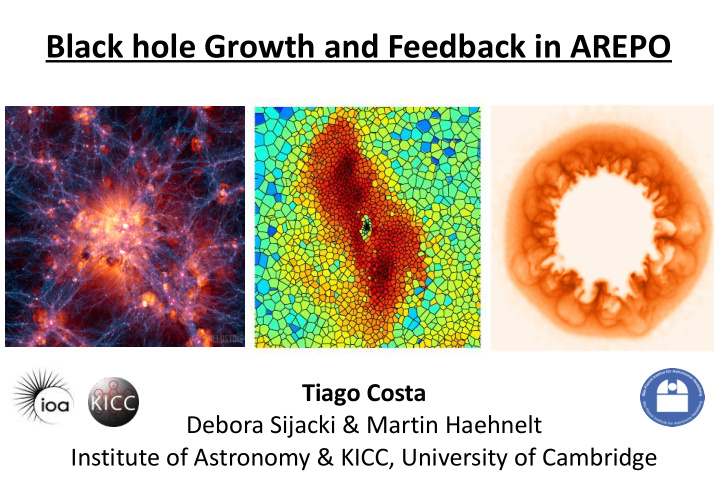



Black hole Growth and Feedback in AREPO Tiago Costa Debora Sijacki & Martin Haehnelt Institute of Astronomy & KICC, University of Cambridge
Black holes in AREPO BHs: collisionless sink particles ● - BH seeding with FOF finder on the fly. - BH growth: via mergers with other BHs (within HSML and if v<c s ) or via gas accretion (Bondi-like) limited to the Eddington rate (Springel et al. 2005, Di Matteo et al. 2005) . with a = 100 x volume averaged Bondi rate for hot and cold ISM.
BH feedback in two modes (analogous with X-ray binaries): ● 1. Quasar feedback if BHAR > (0.01 – 0.05) x Eddington rate - small fraction of bolometric luminosity couples THERMALLY to the surrounding gas. 2. Radio feedback if BHAR < (0.01 – 0.05) x Eddington rate. - THERMAL bubbles (determined by the BH properties) - Bubble radius derived from solutions for radio cocoon expansion (Sijacki et al. 2007) ADDITIONALLY: 3. Radiative feedback from AGNs: - Heats surrounding halo gas, modifies its ionisation state and the net cooling rate (Vogelsberger et al. 2013) 4. Momentum-driven outflows - Inject L/c into BH's neighbours rather than E th (Costa et al. 2014) .
Black holes in ILLUSTRIS BH MASS – BULGE MASS RELATION Sijacki et al. (in prep.) Kormendy & Ho 2013: circles: ellipticals, stars: spirals with bulges, squared: pseudo-bulges GALAXY CATALOGUE: Greg Snyder & Paul Torrey (g, r and I bands)
Exploring different feedback models in AREPO Hernquist (static) potential with: ● DARWIN @ CAMBRIDGE Minimum cell size: ~ 7 pc ● Gas at hydrostatic equilibrium ● Explore range of BH masses: ● Assume AGN is constantly emitting ● at its Eddington limit. COMPLEXITY @ LEICESTER Dirac allocation, PI: Sijacki
Costa, Sijacki and Haehnelt, 2014 Shell of shocked gas expands outwards as envisaged in models of spherical models of isolated haloes (Silk & Rees 1998, Fabian 1999, King 2003)
Energy-driven outflow 800 kpc M BH a s 5 a e t a l . ( 2 0 1 4 ) C o s t Projected gas mass slice Costa, Sijacki and Haehnelt, 2014 cf. King's talk Numerical and analytical wind solutions are in close agreement. Numerical and analytical wind solutions are in close agreement. At late times, R-T instabilities develop and lead to disruption of the shell. At late times, R-T instabilities develop and lead to disruption of the shell.
Momentum-driven outflow 300 kpc M BH a s 4 C o s t a e t a l . ( 2 0 1 4 ) Projected gas mass slice Costa, Sijacki and Haehnelt, 2014 Numerical and analytical solutions agree at high black hole masses .
Anisotropic outflow escapes along paths of least resistance.
No significant momentum-driven outflow for M = M s .
Conclusions ● In isolated potentials, we verify that a momentum flux of L/c is sufficient to lead to a relation: ● A momentum flux >> L/c is however required to revert inflows of gas as predicted by cosmological simulations of BH growth. ● Energy-driven outflows provide the required momentum input. ● New implementation methods, such as super-Lagrangian refinement are a promising tool to study BH growth and feedback in the next generation of cosmological simulations.
Recommend
More recommend